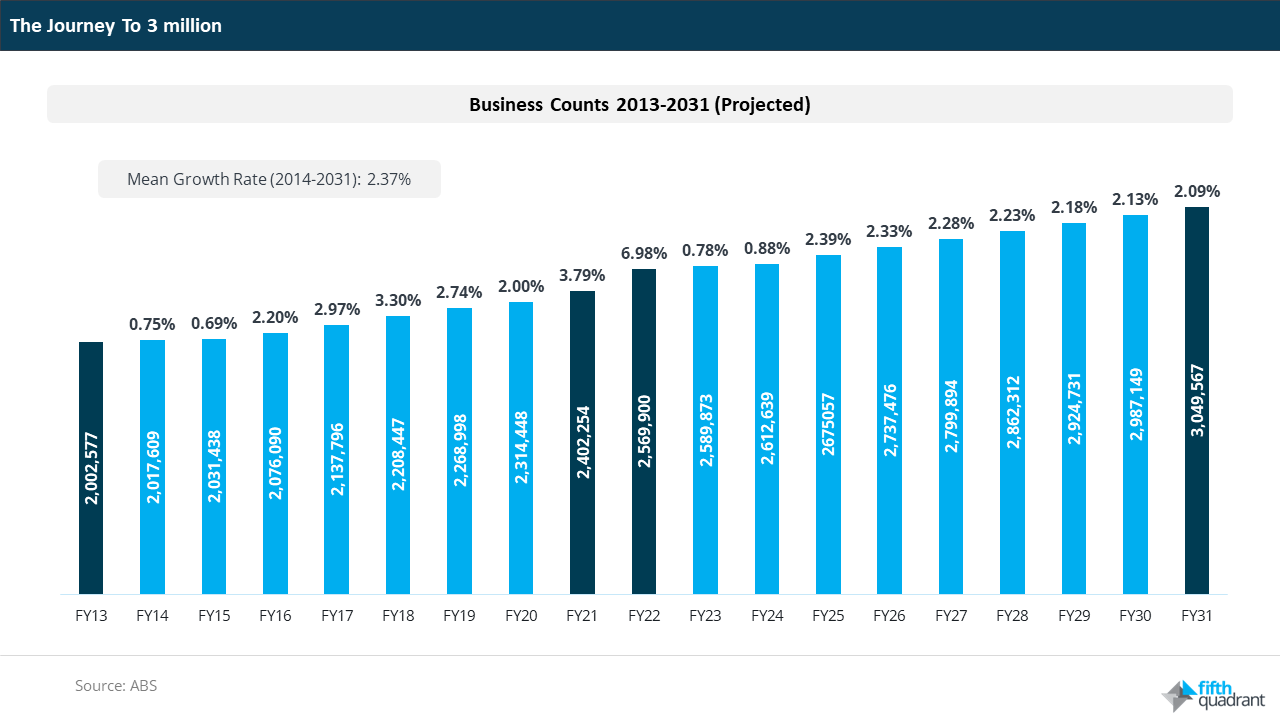Author: Jasper Luck-Chee | Posted On: 08 Mar 2024
Australia’s business sector has shown consistent growth over the years, reaching a total of 2,611,688 businesses by the end of 2023.
Accordingly, we decided to take a look back over the last ten years and consider the future of the business landscape in Australia.
In 2013, reaching a business population of 2 million marked a notable milestone. While the year is better remembered for its political turbulence (3 prime ministers) and blockbuster movies (Gravity, The Wolf of Wall Street, and Frozen) this achievement was a significant sign of resilience and recovery following the turbulent years of the global financial crisis.

In subsequent years the number of businesses continued to climb from 2,002,577 in 2013 to 2,611,688 in 2023. This is an increase of 30%.
Meanwhile, the Australian population grew from approximately 23,300,000 to 26,600,000 over the same period. This is an increase of only 14%!
The growth of the business population outpacing the overall population can be attributed to many factors, including:
- Technological advancements such as digital platforms, cloud computing, and e-commerce.
- A shift towards services like finance, education, and health with lower barriers to entry.
- An increase in gig work and freelancing
- Government support including tax incentives, grants, and support services to encourage small business growth.
- Shifts in work and career attitudes with a greater desire for autonomy and work/life balance
- Access to global markets facilitated by the internet.
- A startup ecosystem for new businesses fuelled by incubators, accelerators, and venture capital.
Clearly technology has been the major enabler of change and was a key reason why we saw accelerated business growth during the pandemic years of 2021 and 2022. Essentially significant life and career decisions were made based on the ability to leverage technology to work anywhere at any time. However, it is also notable that a slowdown in growth in 2023 suggests many new entrants have faced challenges, highlighting the unpredictable nature of self-employment.
While predicting the future is dangerous, extrapolating historic growth trends suggests we should reach 3,000,000 businesses by 2031. It might be sooner, it might be later but be assured there will be many challenges along the way and many unknowns.
- Will geopolitical and social unrest destabilise the business environment?
- How will rapid technological advancements challenge existing business models?
- Can businesses effectively counter cybersecurity threats?
- Will climate change and new regulations impose additional costs?
- How will skills shortages impact small businesses?
- Are regulatory burdens too heavy for aspiring entrepreneurs?
- Will competition stifle growth?
- Can small businesses adapt quickly to changing consumer preferences?
- Is another global pandemic on the horizon?
- Will we get some other nasty unknowns: think dotcom crash, 9/11, GFC
Navigating these challenges will be crucial, but the resilience and adaptability of Australia’s business sector gives us reason to be optimistic about overcoming future obstacles. Only time will tell.
For regular updates about the business landscape including the Fifth Quadrant SME Monthly Tracker please subscribe below. For any questions or inquiries, feel free to contact us here.
Posted in TL, B2B, Consumer & Retail, Financial Services, QN, Social & Government, Technology & Telco

